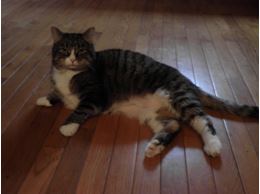A 16-year-old female spayed domestic short-haired cat weighing 6.3kg was evaluated for decreased appetite, hind limb weakness and vomiting. She had been seen by her family veterinarian 3 days prior to presentation to BEVS for “landing hard” after jumping down from the counter.
Significant findings on physical examination consisted of severe ventral neck flexion (cervical ventroflexion) (fig. 1) and profound weakness in her hind limbs.
Figure 1
Clinicopathologic abnormalities included hypokalemia (2.5mmol/L, reference range 3.5-5.8 mmol/L), hyperglycemia (180mg/dL, reference range 71-159mg/dL) and elevated creatine kinase (15319U/L, reference range 64-440U/L). Mild hypertension was noted (blood pressure 160mmHg, systolic). Abdominal ultrasound revealed a homogeneous, 14mm diameter right adrenal mass (fig. 2).
Figure 2
The adrenal mass and markedly elevated serum aldosterone levels (>1376pg/ml, 11.3-294.3pg/ml) are consistent with a diagnosis of primary hyperaldosteronism. At this time an adrenalectomy was recommended. However, the owner elected medical therapy alone.
Treatment while hospitalized consisted of intravenous fluids (IV) (Normosol-R with potassium chloride [KCl] 60mEq/L and Thiamine 100mg at 20ml/hr), spironolactone (12.5mg per os [PO] q 12 hours), and potassium gluconate gel (2mEq PO q 6 hours). Electrolytes and blood pressure were followed q 12 hours and the cat was released to the owner with improved, but still moderate hypokalemia (3.1mmol/L, reference range 3.5-5.8mmol/L).
Treatment at home consisted of spironolactone (12.5mg PO q 12 hours), potassium gluconate gel (4mEq KCl q 12 hours) and cyproheptadine (2mg PO q 24 hours). 10 days after presentation, recheck examination revealed improved overall strength and resolution of the ventral neck flexion. Continued hypokalemia and hyperglycemia were noted on follow-up serum chemistries (2.8mmol/L, reference range 3.5-5.8mmol/L; 265mg/dL, 71-159mg/dl, respectively). Blood pressure was improved (130mmHg systolic). Spironolactone (25mg PO q 12 hours), and potassium gluconate (6mEq KCl am, 4mEq pm) dosages were increased.
By day 30, recheck examination with the family veterinarian revealed persistent moderate hypokalemia (2.8mmol/L, reference range 3.5-5.8mmol/L). On day 60, BEVS received a thank you note from the owner. She indicated Cleo was “back to normal” and enclosed a picture (fig.3)
Figure 3
Common differentials for cervical ventroflexion in cats include hypokalemia, thiamine deficiency, hyperthyroidism, CRD, DM and neuromuscular disease (i.e. Myasthenia Gravis). Clinical signs of weakness, cervical ventroflexion, hypertension, mydriasis, and retinal detachment have been reported in cats with hyperaldosteronism.
Hyperaldosteronism is generally thought to be primary when clinical and laboratory signs are consistent together with the presence of unilateral or bilateral adrenal neoplasia or hyperplasia. Secondary hyperaldosteronism occurs in the presence of chronic renal failure, hepatic failure or congestive heart failure with up-regulation of the renin-angiotensin aldosterone system. Ideally, serum renin concentrations would have been measured to differentiate primary from secondary hyperaldosteronism. However, with normal cardiac, renal and hepatic values, financial concerns and a documented adrenal mass, secondary hyperaldosteronism was thought unlikely in this case.
Ideally, these cases would be managed surgically with an adrenalectomy. But when surgery is not an option, long term control is possible with medical management (anti-hypertensives, aldosterone antagonism and potassium supplementation).
Written by Dr. Bryan Harnett, DACVIM
To Dr. Harnett & staff,
This is a long overdue update and thank you for the care you gave to my kitty Cleo.
Back in late January I brought my very sick kitty to BEVS with no idea what was wrong with her. Dr. Harnett quickly diagnosed her with having low potassium levels. The next morning he found the cause was a growth on her adrenal gland.
After I decided surgery, because of her age, was out of the question she was put on a daily regimen of potassium supplements and spironolactone to control the problem. I give her the powered form of the potassium, mix it in her food and she doesn’t even know its there. Much better than having to give her the caplets 2 – 3 times a day! I am happy to say that after almost three months she is doing quite well. Even though we don’t know what tomorrow will bring or how much longer she will be with us, today, as most days, she is happy & content (and right now snoring up a storm as she sleeps on the back of the sofa).
Again, thank you Dr. Harnett and to everyone who cared for and about my Cleo.
Lori



